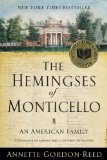Summary | Excerpt | Reviews | Readalikes | Genres & Themes | Author Bio

Critics' Opinion:
Readers' Opinion:
First Published:
Sep 2008, 800 pages
Paperback:
Sep 2009, 800 pages
Although the peoples of Africa and Europe were not unknown to one another, it
is safe to say that the majority of seventeenth-century Africans and English
people would not have been in extensive contact. There had been an African
presence in Great Britain since ancient times, but not a substantial one until
the beginning of the slave trade. Englishmen and their predecessors in the trade
from other parts of Europe created outposts along the African coast in order to
conduct the traffic in human beings, forming alliances with the leaders of those
societies and having children with African women, who often became involved in
the trade themselves. It was in the New World that the lives of these people
with different skin colors became most closely entwined. They greeted one
another in this land as strangers across a divide that was both physical and
cultural, and each had views about the other that centered on notions of
difference and inferiority.
Negative views about the color black existed within English culture long
before Englishmen actually encountered people with "black" skin. Black was evil.
Black was dirty. Although other evidence suggests that people of African origin
were not universally reviled in England, the tendency to see black negatively
was definitely a part of English culture. Naturally, its view of whiteness
carried all the opposite meanings. Color, then, became an expression of a
person's essence.
This was a two-way street, with the Africans thinking along the same lines
about their white counterparts, but in the process reversing the conclusions.
They saw themselves as different from whites and often imbued whiteness with
negative characteristics. Whites were physically ugly—one "African ruler thought
'all Europeans looked like ugly sea monsters'"—cannibalistic, and disfavored by
God. A seventeenth-century European traveler reported that some "local blacks"
he had met said that "'while God created Blacks as well as White Men,' the Lord
preferred the blacks." Others referred to a Danish man as being "'as white as
the devil.'" Once blacks and whites were together in the new world of Virginia,
where Anglo-American colonists controlled society, only the whites' perception
of the meaning of differences between the races counted. They could, and did,
codify their understanding of what it meant to be black and what it meant to be
white, with devastating consequences for people of African origin.
Matters were complicated further because the "Africans" were anything but
monolithic in their cultures. "Black men and women were transported to America
as members of specific tribes—as Ibos, Yorubas, or Ashantis but not simply as
Africans." Africa is the most linguistically, culturally, and genetically
diverse of the continents, and though no one at that time could have dreamed it,
the enslaved Africans, under the skin, at the genetic level, were more
"different" from one another than the English were from their fellow Europeans.
White Virginians, particularly members of the slave-owning class, did
recognize that Africans were not all alike. Over the course of time in the early
days of slavery, some planters even came to prefer workers who were brought from
one region over those from others. But respecting and preserving the culture
of these very diverse people was never the point for the white colonists.
Developing and maintaining a work force were the real issues, and as these goals
were realized, all the various African ethnic groups were gradually subsumed
under the category of enslaved black people. In that more literally minded age,
surface appearances were what counted, and the various shades of black told
Anglo-Virginians everything they thought they needed to know about who could be
a slave and who could not.
Excerpted from The Hemingses of Monticello © Copyright 2008 by Annette Gordon-Reed. Reprinted with permission by W. W. Norton. All rights reserved.





The House on Biscayne Bay
by Chanel Cleeton
As death stalks a gothic mansion in Miami, the lives of two women intertwine as the past and present collide.

The Flower Sisters
by Michelle Collins Anderson
From the new Fannie Flagg of the Ozarks, a richly-woven story of family, forgiveness, and reinvention.

The Funeral Cryer by Wenyan Lu
Debut novelist Wenyan Lu brings us this witty yet profound story about one woman's midlife reawakening in contemporary rural China.
Your guide toexceptional books
BookBrowse seeks out and recommends the best in contemporary fiction and nonfiction—books that not only engage and entertain but also deepen our understanding of ourselves and the world around us.